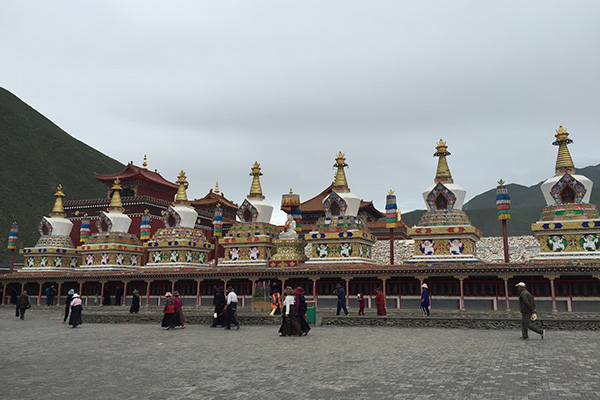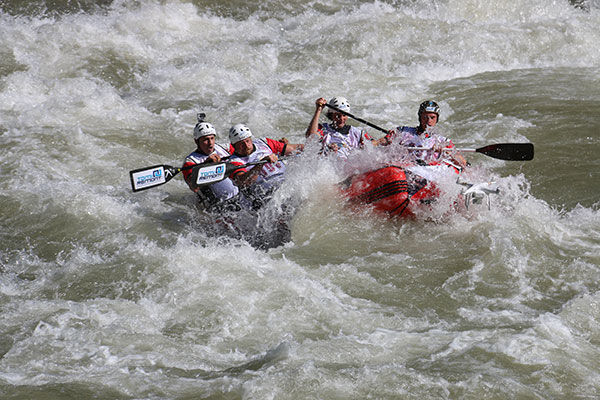
People pray at the Jiana Mani stone square in Yushu city.[Photo/China Daily]
It was not very well known before it was hit by a massive earthquake six years ago, but its charm has been bubbling over ever since.
Last month, nearly 100 rafters from around the world were in Yushu city in the Yushu Tibetan autonomous prefecture in Northwest China’s Qinghai province to experience what it has to offer.
They were there to compete in the Yushu World Cup held over July 19-21.
The water gurgles loudly and splashes over rocks in the shallow parts, producing white waves in the Batang River. You feel that the inflatable boats may capsize at any moment.
This is no ordinary river and you cannot take it for granted. It runs for 7.5 kilometers and ends at a point where it joins the Tongtian River to form the Jinsha River in the upper reaches of the Yangtze.
The point where the green and the yellow rivers converge is a sight to behold.
There, the water flows in different directions, even backward.
Kylie Laxton Blinkhorn from the New Zealand women’s team is impressed by the river.
“We enjoyed the white water,” she says.
“Also, the prayer flags and Tibetan culture made our experience unforgettable. The Tibetan people are warm and friendly.”
Blinkhorn is a whitewater kayaker who has paddled in many parts of the world.
Her team came first overall.
She says the high altitude added to the drama.
“The challenge we faced while rafting here was adjusting to it and trying to keep our breath,” she says.
The Yushu Tibetan autonomous prefecture found favor with the International Rafting Federation president, Joe Willie, during his visit in April. He was impressed by the river and the high-altitude environment.
“The water volume, flow velocity and vertical drop of the river provide a technically challenging course for the competition,” he says, adding that it might be the highest such course in the world.
Contestants from 10 countries, including China, Britain, New Zealand, the Czech Republic and Costa Rica, were in close combat.
The three-day event was the second leg of the three-stop 2016 World Cup series and open to male and female rafters from around the world.
Rafters took part in the sprint, H2H (head-to-head), the slalom, and downriver, the four disciplines in rafting.

Rafters compete in the Batang River at the Yushu World Cup rafting.[Photo/China Daily]
Meanwhile, the local government is striving to draw visitors with its natural resources after a magnitude 7.1 earthquake rocked Yushu city in April 2010, claiming the lives of more than 2,000 people.
The city sits 4,000 meters above sea level and is the birthplace of the Yangtze, the Yellow and the Lancang rivers, which makes it a good destination for rafting events.
Rafters first came to the area more than 30 years ago.
In 1985, Yao Maoshu, a photographer from a university in Southwest China’s Sichuan province, came to Yushu and rafted from the source of the Yangtze.
He took the plunge when he heard that American rafter Ken Warren was trying to do the same and became the first rafter to traverse the Yangtze.
Yao rafted roughly 1,200 kilometers but tragically drowned in rapids in Jinsha River in July that year.
Many followed in his wake, and some lost their lives as well.
In 1986, a group of 46 spent roughly six months rafting from the source of the Yangtze to Shanghai where it meets the East China Sea.
Yushu started to develop rafting about three years ago.
Then, the local government sent personnel to study and understand the sport, says Suonan Zhande, the deputy head of the Yushu culture, sports and tourism authority.
“We’ve also invited experienced rafters to look at our river and pick out routes that are fit for rafting,” says Zhande.
“Rafting equipment is also available and we have rescue teams and other support facilities in place,” he says.
Separately, the Aquatic Sports Administrative Center of China is working with the local government to build a national high-altitude rafting training facility.
Feng Chun from Sichuan, a veteran rafter with 30 years experience, has been invited to help develop rafting in Yushu.
“We should respect nature when rafting and enjoy it,” says Feng.
He suggests that amateur rafters use waterproof or quick-dry clothes as water temperatures are relatively low at high altitudes.
“Rafters should also get adapted to a rafting environment and listen to instructions from their captain,” he says.
As of now, tourists can raft along the Batang River for as little as 100 yuan ($15).
The Tongtian River will also open for tourists soon, says Feng.

A summer resort at Yushu’s grasslands attracts tourists.[China Daily]
